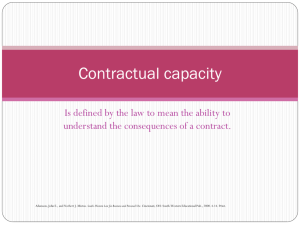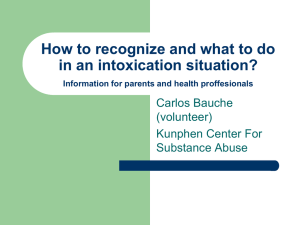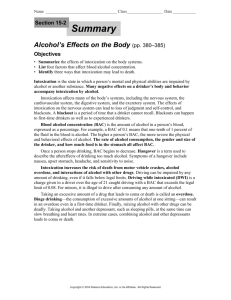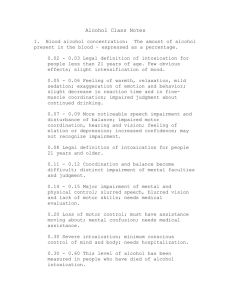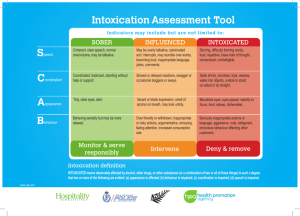Lab 6 Measuring INtoxication (includes pre
advertisement
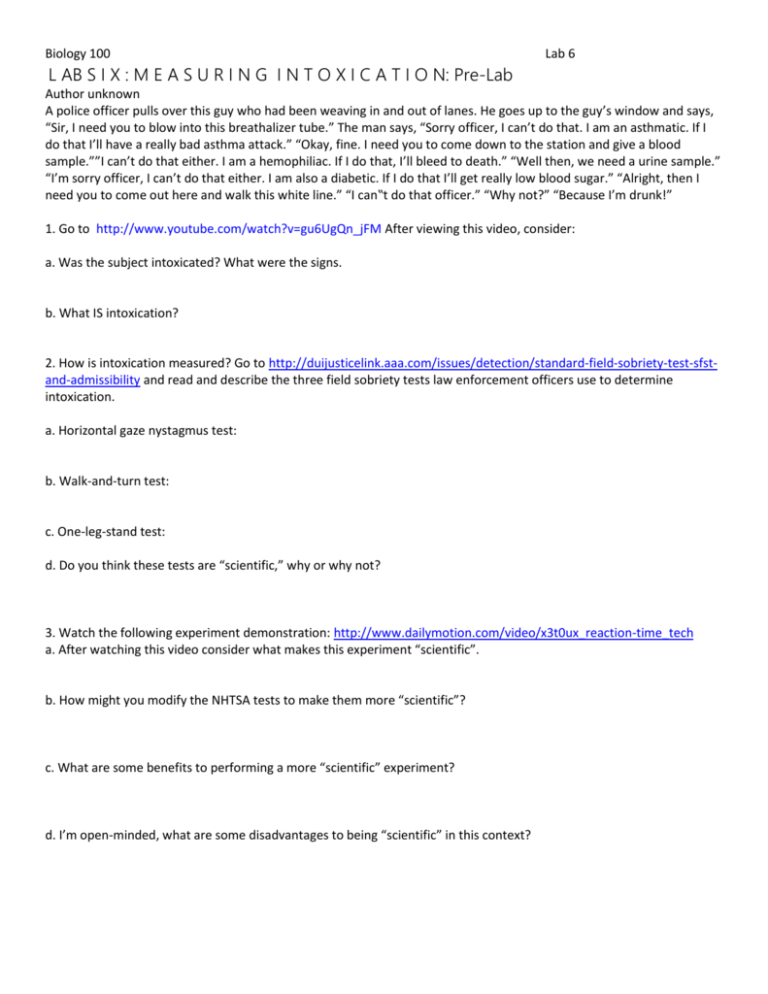
Biology 100 Lab 6 L AB S I X : M E A S U R I N G I N T O X I C A T I O N: Pre-Lab Author unknown A police officer pulls over this guy who had been weaving in and out of lanes. He goes up to the guy’s window and says, “Sir, I need you to blow into this breathalizer tube.” The man says, “Sorry officer, I can’t do that. I am an asthmatic. If I do that I’ll have a really bad asthma attack.” “Okay, fine. I need you to come down to the station and give a blood sample.””I can’t do that either. I am a hemophiliac. If I do that, I’ll bleed to death.” “Well then, we need a urine sample.” “I’m sorry officer, I can’t do that either. I am also a diabetic. If I do that I’ll get really low blood sugar.” “Alright, then I need you to come out here and walk this white line.” “I can‟t do that officer.” “Why not?” “Because I’m drunk!” 1. Go to http://www.youtube.com/watch?v=gu6UgQn_jFM After viewing this video, consider: a. Was the subject intoxicated? What were the signs. b. What IS intoxication? 2. How is intoxication measured? Go to http://duijusticelink.aaa.com/issues/detection/standard-field-sobriety-test-sfstand-admissibility and read and describe the three field sobriety tests law enforcement officers use to determine intoxication. a. Horizontal gaze nystagmus test: b. Walk-and-turn test: c. One-leg-stand test: d. Do you think these tests are “scientific,” why or why not? 3. Watch the following experiment demonstration: http://www.dailymotion.com/video/x3t0ux_reaction-time_tech a. After watching this video consider what makes this experiment “scientific”. b. How might you modify the NHTSA tests to make them more “scientific”? c. What are some benefits to performing a more “scientific” experiment? d. I’m open-minded, what are some disadvantages to being “scientific” in this context? Biology 100 Lab 6 LABSIX:MEASURING INTOXICATION GOALS: To learn how intoxication is quantified and observed. To learn how behavioral response is influenced by environmental factors. To understand specific types of intoxication, as well as symptoms. To understand the difference between subjective judgment and objective measurement MODEL I: IMPORTANT – read these instructions all the way through before you go to the video. You will be asked to pause the video prior to its conclusion. http://www.youtube.com/watch?v=XqLeCZeKDj4 This video takes you (rather a woman suspected of driving drunk) through the three National Highway Transportation Safety Association’s (NHTSA) approved Field Sobriety tests. 3 and a half minutes into the video, she will be in the middle of the one-leg stand test. I WILL STOP THE VIDEO HERE. Decide if YOU would pass or fail the woman before proceeding. 1 – Do you pass or fail this woman. SUPPORT your answer and see if your lab partners agree with you. Let’s see how you and your partners perform on the NHTSA tests and a couple of “scientific” tests. For this the lab, you will work in pairs. One person is the subject, the other is the tester. You might want to switch notebooks with your partner. That way, the tester can record the subject’s data in her own notebook. For each test there will be sufficient time for you to EACH have a chance to be the subject. PART I: FIELD SOBRIETY TESTS A) Horizontal Gaze Nystagmus (HGN) http://www.youtube.com/watch?v=YntJiBCz3pA&feature=related for clarification The HGN is a test that examines a potentially intoxicated subject for his ability to smoothly track an object moving in his visual field. An officer has the subject hold his head steady and follow the movements of the object while the officer watches the subject’s eyes. Refer to the illustration and notice that directly in front of the nose is the reference point (0o) and all other positions in a horizontal plane are assigned increasing values, with 90o at the ears. The officer is looking for the position at which the subject is unable to smoothly swing the angle of his eye to follow the object (nystagmus means eye jerk). You can measure this angle (unlike the officer in the field) because we have vision discs for you to use. See photo/ demonstration for how to wear it. How does intoxication affect the response? We’ll reveal that at the end of the lab. * a few people fail to show ANY eye-jerking movements – even at extreme angles. For these people, please record the angle at which they no longer can see the object. 2- The angle of your nystagmus is: B) The one-leg-stand test 3 – You’ve seen the one-leg stand test performed. Why would an intoxicated person perform poorly? Think of at least 3 reasons. The instructions for this test are available ONLY for the person role-playing the officer. The subject must do as instructed by the “officer”. Your “grade” on the one-leg stand test is: C) Walk-and-turn test 4a – In addition to the ideas you had above, come up with one NEW reason for failing. Is this test more or less difficult than the one-leg stand? 4b – How might the officer who is performing the test influence the outcome? Once again, the instructions are only viewable by the “officer”. Switch roles! Your walk-and-turn score is: D) Other test we WON’T perform (“non-standard tests”) There are some states that use other tests to measure sobriety, but these are poorly supported by scientific studies and are not supported by the NHTSA. These include the finger-to-nose test, a counting test (counting backward by threes, for instance), and an alphabet test. The finger-to-nose test is a test for your sense of proprioception. Proprioception is your ability to determine where your body parts are in space relative to the other parts. Proprioception is not influenced by alcohol in the way that balance is, although it does require cognitive processing in order to act appropriately upon signals from the sensory cells. The counting and alphabet tests are merely tests of computation, recitation and memory. 5 – A counting and alphabet test can allow one to analyze cognitive functioning. Why are they not recommended tests? 6– Rethink your definition of “intoxication” (question 1). Do the tests you just completed test for ANY type of intoxication? PART II: RESEARCH LAB TESTS FOR INTOXICATION You will use two different tests today to help you consider your thoughts about benefits to more “scientific” tests of sobriety (question 5). A) Testing and Modifying Reaction Time Have the subject sit on a chair and hold her fingers open around the base of a meter stick. The tester will hold the top of the stick. With no warning, the tester will release the meter stick. When the subject notes its motion, she should grab it between the thumb and finger of one hand. Note the distance (IN METERS!) at which the thumb touches the stick. Goggles are required for this part of the experiment! Repeat this test 9 more times and place your data on the following chart. 7– Why did we ask you to average trials 6 – 9 and ignore trials 1 – 5? 8 – How will distraction change the position on the meter stick that you catch at? a. Will the distance on the meter stick increase or decrease? b. Will the reaction TIME (units in seconds) increase or decrease? Now test how your reaction time depends upon the other “traffic” that is going on in the brain. How does concentration – or lack of it – affect reaction time? (Think about this the next time you study in front of the TV!). Conversation alone is not particularly distracting. If it were, think about what would happen when driving with a friend in the car! There are numerous ways that you might alter the concentration of your subject. Be creative! You could have him count backward, speak in a foreign language, or “say” the alphabet in ASL. Make the distraction a REAL distraction – make it tough! Play safe, but have fun! 1 2 3 4 What is your distracted, average reaction time? 5 B) Testing and Modifying Stroop Time The Stroop test was named after its discoverer, a scientific one-hit-wonder. After describing the test, Brother Stroop went back to the church and hundreds of scientists took up where he left off – using the test in countless variations. We’ll use a Bio 110- variation that simulates how some research labs use the Stroop test to analyze intoxication of subjects. During each round of testing, the subject will have one job: to name the COLOR of the objects that the tester points to. The tester has two jobs in addition to pointing to objects. He must record the time it takes the subject to complete the card and he must record the number of errors your subject makes. Errors? Seems unlikely, but there WILL be errors made on this test thanks to Stroop’s twist which we will not reveal until you come into lab. Repeat each level as indicated by the data tables shown. Level 2 is called “Congruent” and level 3 is called “Incongruent” (if you don’t know the meaning of these words, ask during lab – I don’t want to give too much away before you perform the tests). So what is really interesting is to see how much longer your solving time is when performing an incongruent test as compared to a congruent test. Compute your INCONGRUENT average – your congruent average = MODEL II: An “Expert Witness”, Dr. Greg Kane has a strong interest in the claims regarding the accuracy of field sobriety tests. On his web site, he presents previously-obtained data showing the correlation (or not) of the one-leg stand test vs. blood alcohol content (BAC). 9 – Is the one-leg stand (OLS) a GOOD test for intoxication? Think like a defense attorney. PART III: OPTIONAL If you and your partner find yourself with extra time before wrap up, consider performing the following modifications of part II. Option A: Return to the reaction time test (meter stick drop). This time, have the subject close his/her eyes and use another stimulus to “announce” the drop of the meter stick. You could use an auditory stimulus (saying “now”) or you could use a touch stimulus (tapping a shoulder). Either way, the tester must be careful that the new stimulus is delivered when the stick is dropped. Make a prediction – will visual or other stimulus be faster to the brain and therefore enable a speedier reaction time? Option B: Return to the stroop test. Try performing level 2 and 3 again – but this time, do it when distracted. We’ve fou Before you leave, be sure you can answer all questions so far presented as well as these wrap up questions. I. What type of intoxication are field sobriety tests geared toward? Does this mean that other drugs are not intoxicating? II. What do the reaction time and stroop test offer that the field sobriety tests lack? III. Which field sobriety test is most reliable? How reliable is it – explain – why is it not perfectly reliable?
